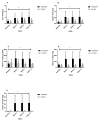Nutritional Supplementation Concurrent with Nutrition Education Accelerates the Wound Healing Process in Patients with Diabetic Foot Ulcers
- PMID: 32756299
- PMCID: PMC7460445
- DOI: 10.3390/biomedicines8080263
Nutritional Supplementation Concurrent with Nutrition Education Accelerates the Wound Healing Process in Patients with Diabetic Foot Ulcers
Abstract
Trials on nutritional supplements for the treatment of diabetic foot ulcer (DFU) have only evaluated the effects of supplementation with specific nutrients. Additionally, nutrition education has not been a systematic part of these studies. The aim of this study was to evaluate the effects of a nutrient-dense formula combined with nutrition education on wound healing in DFU patients. Twenty-nine patients were randomly assigned to the treatment group (n = 15) receiving two servings of supplements daily plus nutrition education or control group (n = 14) that received the standard of care but no additional nutritional or educational intervention. Both groups were followed for a maximum of 12 weeks. Wound healing, as measured by planimetry, was examined at baseline and every four weeks until complete wound closure or up to 12 weeks. There were no significant differences between groups for BMI, age, duration of diabetes, wound age estimation, or wound area at baseline. The treatment group experienced a faster wound healing rate (6.43 mm2/week more reduction in the wound area) than the control group. The mean reduction in the wound area during the first four weeks of the study was almost 13-fold greater in the treatment group compared to the control group (18.0 mm2/week vs. 1.4 mm2/week, respectively). Our findings showed that nutrition supplementation plus nutrition education significantly accelerated wound healing in DFU patients compared to those who just received a standard-of-care regimen.
Keywords: antioxidants; diabetes; diabetic foot ulcers; malnutrition; nutrition education; nutrition supplementation; wound healing.
Conflict of interest statement
The authors declare no conflict of interest.
Figures




Similar articles
-
Improving Dietary Intake of Essential Nutrients Can Ameliorate Inflammation in Patients with Diabetic Foot Ulcers.Nutrients. 2022 Jun 9;14(12):2393. doi: 10.3390/nu14122393. Nutrients. 2022. PMID: 35745123 Free PMC article. Clinical Trial.
-
Systematic reviews of wound care management: (3) antimicrobial agents for chronic wounds; (4) diabetic foot ulceration.Health Technol Assess. 2000;4(21):1-237. Health Technol Assess. 2000. PMID: 11074391 Review.
-
A Prospective, Descriptive Study to Assess the Clinical Benefits of Using Calendula officinalis Hydroglycolic Extract for the Topical Treatment of Diabetic Foot Ulcers.Ostomy Wound Manage. 2016 Mar;62(3):8-24. Ostomy Wound Manage. 2016. PMID: 26978856 Clinical Trial.
-
Poorly designed research does not help clarify the role of hyperbaric oxygen in the treatment of chronic diabetic foot ulcers.Diving Hyperb Med. 2016 Sep;46(3):133-134. Diving Hyperb Med. 2016. PMID: 27723012
-
Nutritional supplementation on wound healing in diabetic foot: What is known and what is new?World J Diabetes. 2022 Nov 15;13(11):940-948. doi: 10.4239/wjd.v13.i11.940. World J Diabetes. 2022. PMID: 36437863 Free PMC article. Review.
Cited by
-
Exploring the Interrelationships between Diabetes, Nutrition, Anxiety, and Depression: Implications for Treatment and Prevention Strategies.Nutrients. 2023 Sep 30;15(19):4226. doi: 10.3390/nu15194226. Nutrients. 2023. PMID: 37836510 Free PMC article. Review.
-
Collagen-Containing Fish Sidestream-Derived Protein Hydrolysates Support Skin Repair via Chemokine Induction.Mar Drugs. 2021 Jul 15;19(7):396. doi: 10.3390/md19070396. Mar Drugs. 2021. PMID: 34356821 Free PMC article.
-
Perceptions of Diet Quality, Advice, and Dietary Interventions in Individuals with Diabetes-Related Foot Ulceration; A Qualitative Research Study.Nutrients. 2022 Jun 14;14(12):2457. doi: 10.3390/nu14122457. Nutrients. 2022. PMID: 35745190 Free PMC article.
-
Improving Dietary Intake of Essential Nutrients Can Ameliorate Inflammation in Patients with Diabetic Foot Ulcers.Nutrients. 2022 Jun 9;14(12):2393. doi: 10.3390/nu14122393. Nutrients. 2022. PMID: 35745123 Free PMC article. Clinical Trial.
-
A retrospective cohort study on enhanced recovery after surgery (ERAS) in patients with diabetic foot ulcer.Sci Rep. 2024 Aug 6;14(1):18171. doi: 10.1038/s41598-024-69150-8. Sci Rep. 2024. PMID: 39107400 Free PMC article.
References
-
- CDC CDC Press Releases. [(accessed on 7 March 2019)];2016 Available online: https://www.cdc.gov/media/releases/2017/p0718-diabetes-report.html.
-
- Maier H.M., Ilich-Ernst J., Arjmandi B., Kim J.-S., Spicer M. Deficiencies in Nutritional Intake in Patients with Diabetic Foot Ulcers. J. Nutr. Ther. 2016;5:85–92. doi: 10.6000/1929-5634.2016.05.04.1. - DOI
LinkOut - more resources
Full Text Sources

